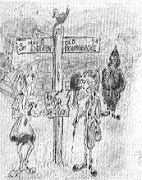
Directed by Rudolph Mate; starring Edmond O'Brien
As the credits roll, a man enters a police station and strides purposefully through long corridors until he comes to the door marked ‘Homicide’. He asks for the captain and says he’s there to report a murder.
‘Who was murdered?’
‘I was.’
And the flashback begins. This is film noir. It’s a good opening. Brisk, efficient and arresting. But it’s not maintained, more’s the pity.
Edmond O’Brien is the small-time accountant who fancies a week of fun and relaxation – let’s call it - in San Francisco. When we meet his girlfriend, it’s easy to see why. She’s not exactly a ‘femme fatale’, but she’d certainly be fatal to any man’s enjoyment of life. She whines, she clings and she has a nice line in guilt inducement.
Edmond finds the strength to get to San Francisco and is immediately surrounded by attractive women, each one signalled by an irritating wolf-whistle on the sound track. Having managed, with amazing ease, to pick up a woman in a bar, he has cold water poured over his libido by the arrival of flowers and a ‘missing you already’ note from the girlfriend.
It’s about now that he is poisoned. No, it’s not suicide. It’s a conspiracy. The next morning, feeling that his hangover is unusually bad, he consults a remarkably well-informed doctor, an expert in toxicology, who informs him that he has taken ‘luminous toxin’ and has a day or two to live.
Somewhat taken aback he rushes out and runs through the streets, an impressive sequence, all the better because the crowds on the pavement were probably not informed of what was going on.
A second opinion confirms the first and is reinforced when we actually see the poison glowing in the dark. That settles it. Doomed. There’s nothing left to do but find the man who administered it and solve the mystery.
That’s what the film basically is, a mystery, a standard murder mystery. It attempts to add darkness by the idea of the victim doing the investigation and perhaps a little philosophical weight by alluding to the absurdity of his fate. But this is all forgotten as the puzzle develops with a dizzying parade of look-alike women and villains. O’Brien’s angst is lost in all this. All we get by way of character development is his sudden realisation that he loves his girlfriend. He’s obviously not thinking straight, but then I suppose you can hardly blame him.
It’s a pity, because O’Brien is good. He’s in every scene and carries the whole film. The earliest film of his I recall is The Hunchback of Notre Dame, when he was slim and good-looking and difficult to recognise as the same man hamming it up in The Man Who Shot Liberty Valance and The Wild Bunch – and let’s not forget The Girl Can’t Help It. Here he’s restrained and solid and makes me wonder if he wasn’t worthy of greater things than he achieved.
‘I was.’
And the flashback begins. This is film noir. It’s a good opening. Brisk, efficient and arresting. But it’s not maintained, more’s the pity.
Edmond O’Brien is the small-time accountant who fancies a week of fun and relaxation – let’s call it - in San Francisco. When we meet his girlfriend, it’s easy to see why. She’s not exactly a ‘femme fatale’, but she’d certainly be fatal to any man’s enjoyment of life. She whines, she clings and she has a nice line in guilt inducement.
Edmond finds the strength to get to San Francisco and is immediately surrounded by attractive women, each one signalled by an irritating wolf-whistle on the sound track. Having managed, with amazing ease, to pick up a woman in a bar, he has cold water poured over his libido by the arrival of flowers and a ‘missing you already’ note from the girlfriend.
It’s about now that he is poisoned. No, it’s not suicide. It’s a conspiracy. The next morning, feeling that his hangover is unusually bad, he consults a remarkably well-informed doctor, an expert in toxicology, who informs him that he has taken ‘luminous toxin’ and has a day or two to live.
Somewhat taken aback he rushes out and runs through the streets, an impressive sequence, all the better because the crowds on the pavement were probably not informed of what was going on.
A second opinion confirms the first and is reinforced when we actually see the poison glowing in the dark. That settles it. Doomed. There’s nothing left to do but find the man who administered it and solve the mystery.
That’s what the film basically is, a mystery, a standard murder mystery. It attempts to add darkness by the idea of the victim doing the investigation and perhaps a little philosophical weight by alluding to the absurdity of his fate. But this is all forgotten as the puzzle develops with a dizzying parade of look-alike women and villains. O’Brien’s angst is lost in all this. All we get by way of character development is his sudden realisation that he loves his girlfriend. He’s obviously not thinking straight, but then I suppose you can hardly blame him.
It’s a pity, because O’Brien is good. He’s in every scene and carries the whole film. The earliest film of his I recall is The Hunchback of Notre Dame, when he was slim and good-looking and difficult to recognise as the same man hamming it up in The Man Who Shot Liberty Valance and The Wild Bunch – and let’s not forget The Girl Can’t Help It. Here he’s restrained and solid and makes me wonder if he wasn’t worthy of greater things than he achieved.
My overall judgment: good basic concept, let down by the script. Worth watching for efficiency of direction and photography. And O’Brien’s performance.

No comments:
Post a Comment